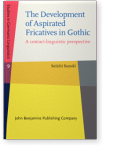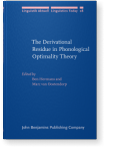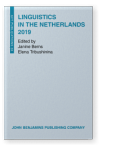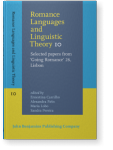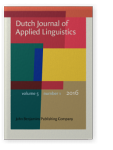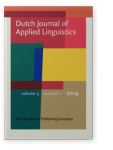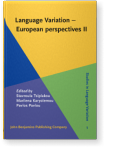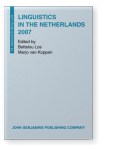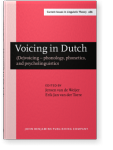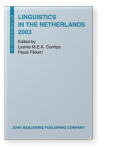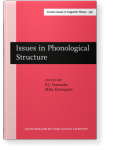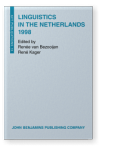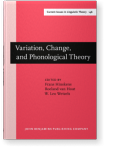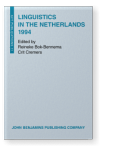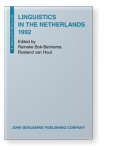Marc van Oostendorp
List of John Benjamins publications for which Marc van Oostendorp plays a role.
Book series
Title
The Derivational Residue in Phonological Optimality Theory
Edited by Ben Hermans and Marc van Oostendorp
[Linguistik Aktuell/Linguistics Today, 28] 1999. viii, 321 pp.
Subjects Phonology | Theoretical linguistics
2019 Dutch linguistics and the general audience Linguistics in the Netherlands 2019, Berns, Janine and Elena Tribushinina (eds.), pp. 49–53 | Article
2018 Chapter 20. Metaphony as magnetism Structuring Variation in Romance Linguistics and Beyond: In honour of Leonardo M. Savoia, Grimaldi, Mirko, Rosangela Lai, Ludovico Franco and Benedetta Baldi (eds.), pp. 297–306 | Chapter
Metaphony in Romance poses a well-known problem for Element Theory, as it seems to involve lowering. [D’Alessandro and van Oostendorp (2016)] propose to solve this by assuming some suffixes are ‘ |A| Eaters’, absorbing the |A| element from the stem vowel without getting phonetically realized… read more
2017 Chapter 5. On silent markedness Beyond Markedness in Formal Phonology, Samuels, Bridget D. (ed.), pp. 101–120 | Chapter
Empty categories – positions in phonological representations that have no direct phonetic counterpart – are (still) controversial in phonological theory. In this paper we give the main arguments for assuming such positions and we furthermore establish a markedness hierarchy for empty positions:… read more
2017 Chapter 12. Extending categorial grammar to phonology Crossroads Semantics: Computation, experiment and grammar, Reckman, Hilke, Lisa Lai-Shen Cheng, Maarten Hijzelendoorn and Rint Sybesma (eds.), pp. 193–205 | Chapter
Abstract
What would be the implications of applying categorial grammar technology to phonological structure? We show how expressing phonological insights requires a few extensions into the formalism in order to be able to deal with autosegmentalism, with feature repulsion and with… read more
2016 When imperfections are perfect: Prosody, phi-features and deixis in Central and Southern Italian vocatives Romance Languages and Linguistic Theory 10: Selected papers from 'Going Romance' 28, Lisbon, Carrilho, Ernestina, Alexandra Fiéis, Maria Lobo and Sandra Pereira (eds.), pp. 61–82 | Article
Vocatives are often considered as exceptions to the regularity of language, and therefore often put “outside” of grammar, and pertaining instead to speech. In this paper, we wish to show that this conceptualization of vocatives is wrong: not only are they perfectly regular, but they give us… read more
2012 Bilingualism versus multilingualism in the Netherlands Language Problems and Language Planning 36:3, pp. 252–272 | Article
What are the consequences of the rise of English for the languages spoken in the Netherlands, a medium-sized EU Country in which most of the inhabitants speak a medium-sized language? There are several indications that the Dutch are moving from being a traditionally multilingual population,… read more
2009 Sources of phonological variation in a large database for Dutch dialects Language Variation – European perspectives II: Selected papers from the 4th International Conference on Language Variation in Europe (ICLaVE 4), Nicosia, June 2007, Tsiplakou, Stavroula, Marilena Karyolemou and Pavlos Pavlou (eds.), pp. 103–118 | Article
The so-called Goeman-Taeldeman-Van Reenen Project (GTRP) consists of a large online database of 613 local dialects of Dutch on the basis of which the phonologies of these dialects can be systematically compared. In this paper we present a quantitative investigation of an aspect of the reliability… read more
2007 Feature co-occurrence constraints in L1 acquisition Linguistics in the Netherlands 2007, Los, Bettelou and Marjo van Koppen (eds.), pp. 162–172 | Article
2007 3. Exceptions to final devoicing Voicing in Dutch: (De)voicing – phonology, phonetics, and psycholinguistics, Weijer, Jeroen van de and Erik Jan van der Torre (eds.), pp. 81–98 | Article
Some dialects of Dutch show systematic exceptions to final devoicing in the first person singular of verbs ending in a long or tense vowel and a fricative. This observation raises questions about the morphology – what makes the first person singular of verbs so special? –, and about the phonology –… read more
2005 Low Saxon possessive pronominals: Syntax and phonology Linguistics in the Netherlands 2005, Doetjes, Jenny and Jeroen van de Weijer (eds.), pp. 73–86 | Article
2003 The structure of Dutch /au/ Linguistics in the Netherlands 2003, Cornips, Leonie and Paula Fikkert (eds.), pp. 167–176 | Article
2000 Voice–tone interaction in a Limburg dialect: Evidence for feature licensing Linguistics in the Netherlands 2000, Hoop, Helen de and Ton van der Wouden (eds.), pp. 81–91 | Article
1999 Italian s-voicing and the structure of the phonological word Issues in Phonological Structure: Papers from an International Workshop, Hannahs, S.J. and Mike Davenport (eds.), pp. 197–214 | Article
1999 Introduction: Optimality Theory and Derivational Effects The Derivational Residue in Phonological Optimality Theory, Hermans, Ben and Marc van Oostendorp (eds.), pp. 1 ff. | Article
1998 Economy of Representation in the Esperanto Word Linguistics in the Netherlands 1998, Bezooijen, Renée van and René Kager (eds.), pp. 175–186 | Article
1997 Style Levels in Conflict Resolution Variation, Change, and Phonological Theory, Hinskens, Frans L., Roeland van Hout and W. Leo Wetzels (eds.), pp. 207–229 | Article
1994 Affixation and integrity of syllable structure in Dutch Linguistics in the Netherlands 1994, Bok-Bennema, Reineke and Crit Cremers (eds.), pp. 151–162 | Article
1992 The grid of the French syllable Linguistics in the Netherlands 1992, Bok-Bennema, Reineke and Roeland van Hout (eds.), pp. 209–221 | Article
